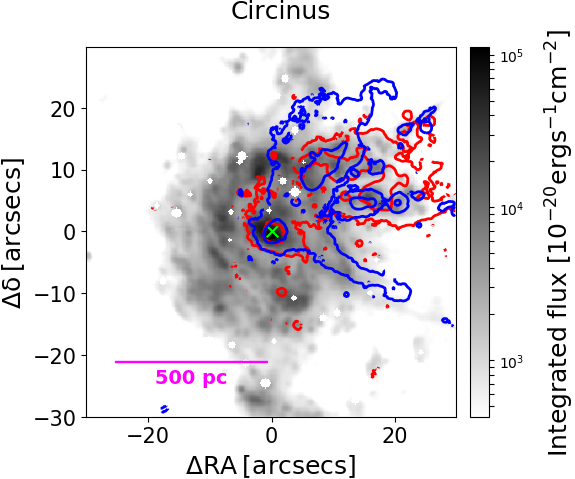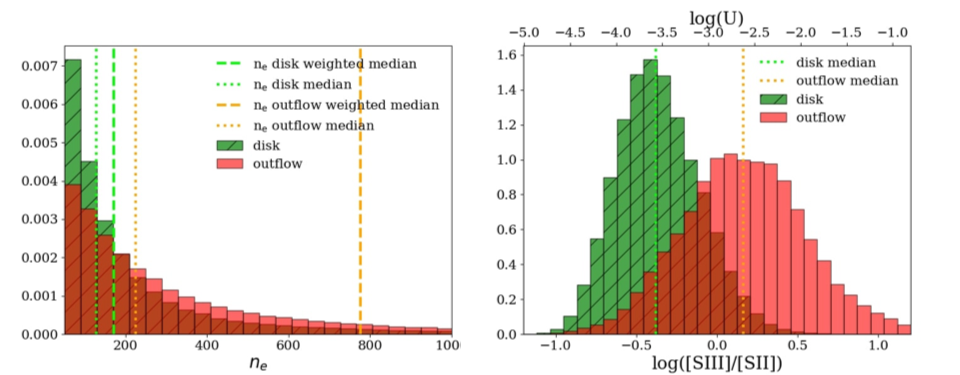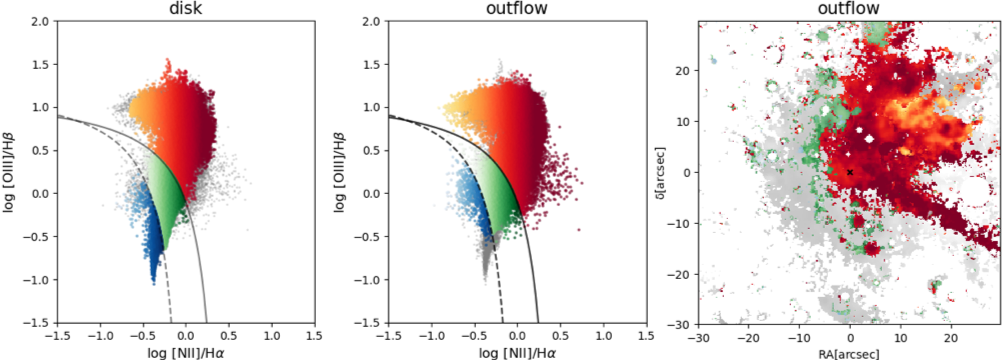Investigating the outflowing gas properties in nearby active galaxies with MUSE
Galaxy-scale outflows driven by active galactic nuclei (AGN) are thought to be so powerful to sweep away most of the gas of the host galaxy, providing a mechanism for the central black hole to possibly regulate star formation (SF). Outflows are now routinely detected in luminous active galaxies on different physical scales, and in different gas phases (e.g., ionised, atomic and molecular gas), but further detailed investigations of their properties and how they are related to SF are required in order to understand their role in galaxy evolution.
In this context, Matilde Mingozzi – Ph.D. student at the University of Bologna and at the Arcetri Observatory – and her collaborators (including among others G. Cresci, G. Venturi, A. Marconi, F. Mannucci, M. Perna, A. Gallazzi, E. Nardini, P. Tozzi and S. Zibetti ofthe Arcetri Observatory) have presented in a paper published in Astronomy & Astrophysics their results obtained with the MAGNUM survey (Measuring Active Galactic Nuclei Under MUSE Microscope, P.I. A. Marconi). This survey observes with the MUSE spectrograph the nearest galaxies hosting an AGN, aiming at probing the physical conditions of their inner regions and the properties of outflows with unprecedented detail, resolving the structure and kinematics down to scales of single clouds (∼ 20 − 240 pc for distances of 4 − 50 Mpc).
In the paper, the authors analyse how interstellar medium (ISM) properties (e.g. density, temperature, ionisation, reddening) and the relative contributions of different ionisation mechanisms vary within individual galaxies, all characterised by prominent conical or biconical outflows. To do this, they created spatially and kinematically resolved maps, disentangling the galaxy disc and outflow components with an innovative approach, in order to compare their gas properties (Figure 1).
 |
Figure 1: Map of the disc component of the Hα flux for the Circinus galaxy. Contours of the outflow component of the [OIII]λ5007 flux are superimposed. The blueshifted and redshifted outflow emission (in blue and red, respectively) is extended in a kiloparsec-scale conical distribution. |
The outflowing gas of the MAGNUM galaxies has higher values of density and ionisation (traced by [SII]λ6716/[SII]λ6731 and [SIII]λ9069,9533/[SII]λ6716,31 line ratios, respectively) than the disc component, which presents a higher dust extinction (estimated from Hα/Hβ). For example, Fig. 2 shows the density and ionisation parameter distributions of all the galaxies for the disc and outflow components, separately. Interestingly, the median outflow density is lower with respect to what found in the literature, unless it is obtained by weighting for the line flux. Therefore, the authors argue that many values of outflow density found in the literature could be biased towards higher ne because they are based only on the most luminous outflowing regions.
 |
| Figure 2: Comparison of the disc (green with stripes) and outflow (red) component distributions for all the MAGNUM galaxies in terms of density ne and of ionisation parameter log(U) traced by log([SIII]/[SII]) (left and right panel, respectively). The light green and orange dotted lines represent the median of the disc and outflow distributions, respectively. The dashed lines in the left panel represents the median values weighted on the [SII] line flux. |
Spatially and kinematically resolved emission line diagnostic diagrams allow to explore the dominant source of ionisation in each region of the disc and outflow components of MAGNUM galaxies. Fig. 3 shows the emission line diagnostic diagrams ([NII]/Hα vs [OIII]/Hβ) of the Circinus galaxy for the disc and outflow components, as well as the corresponding position on the map of the outflowing gas component, colour-coloured based on the different sources of ionisation (i.e. blue for SF, green for composite and red for AGN).
 |
| Figure 3: Emission line diagnostic diagrams for the disc and outflow components, and the corresponding outflow map (left, central and right panels respectively) of the Circinus galaxy, colour-coded on the basis of the ionization source (blue for SF, green for intermediate, red for AGN). |
As Fig. 3 shows, the outflow spans a wider range of [NII]/Hα, including lower and higher values, compared to the disc, highlighted in orange and dark red respectively. The lowest [NII]/Hα line ratios correspond to the high-ionisation regions (high [SIII]/[SII]) and generally trace the innermost parts along the axis of the emitting cones. The highest values of [NII]/Hα line ratios, instead, are characterised by low-ionisation (low [SIII]/[SII]) and follow the cone edges, as shown for the Circinus galaxy, and/or the regions perpendicular to the axis of the outflow. A possible explanation for the observed features identified in the outflow is to take into account different proportions of two distinct populations of line emitting clouds. One is optically thin to the radiation and characterised by the highest excitation, while the other, optically thick, is impinged by a filtered - and then harder - radiation field, and hence characterised by low-excitation.
The results of this work are published in:
The MAGNUM survey: different gas properties in the outflowing and disk components in nearby active galaxies with MUSE, Mingozzi et al, A&A, in press (also available here)
For further information on the MAGNUM survey read previous publications and news:
The MAGNUM survey: positive feedback in the nuclear region of NGC 5643 suggested by MUSE, Cresci et al, 2015, A&A, 582, 63
An unprecedented view on ionized gas and outflows in the nearby active galaxy NGC 1365
Edited by M. Mingozzi and A. Gallazzi



